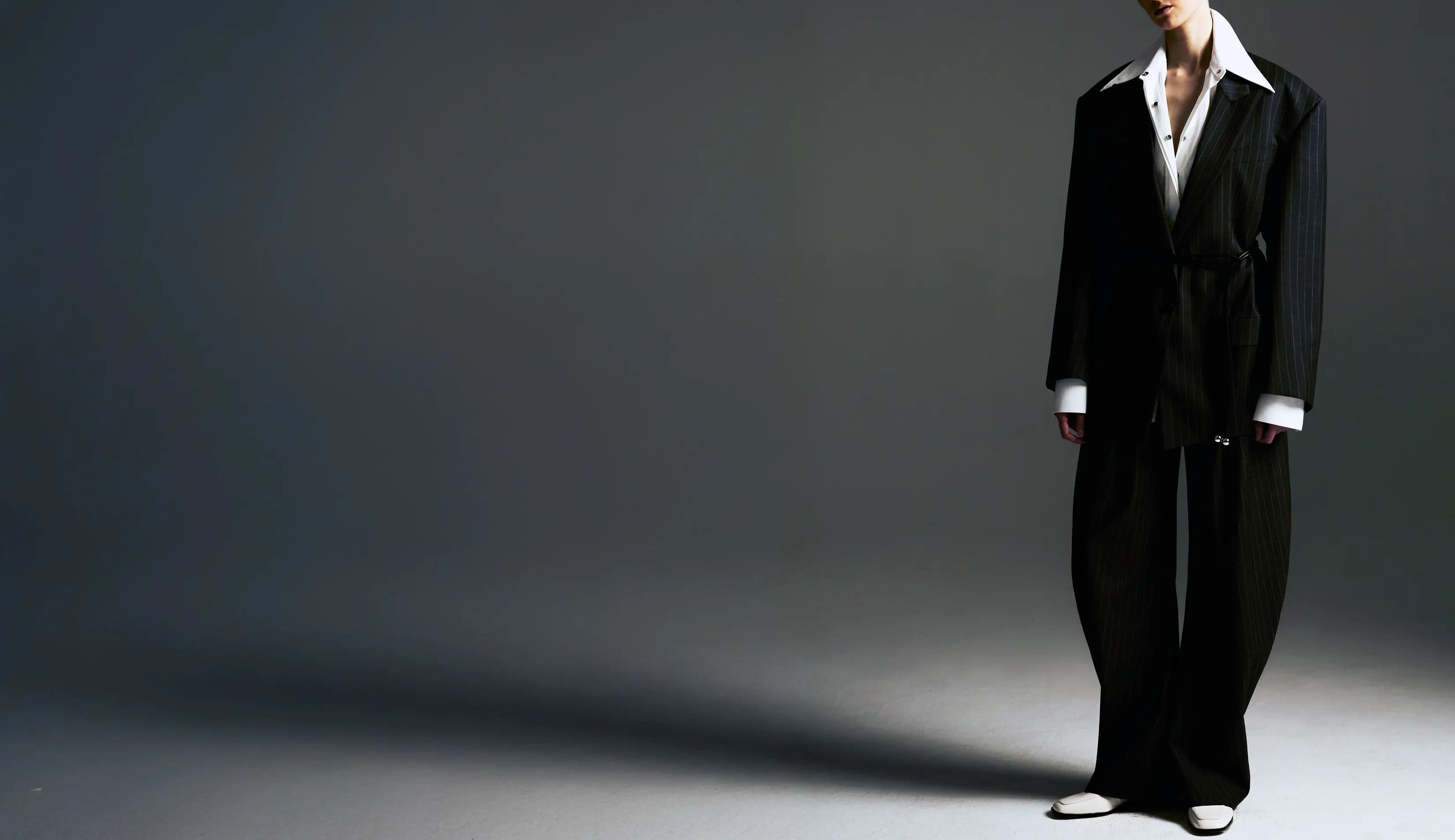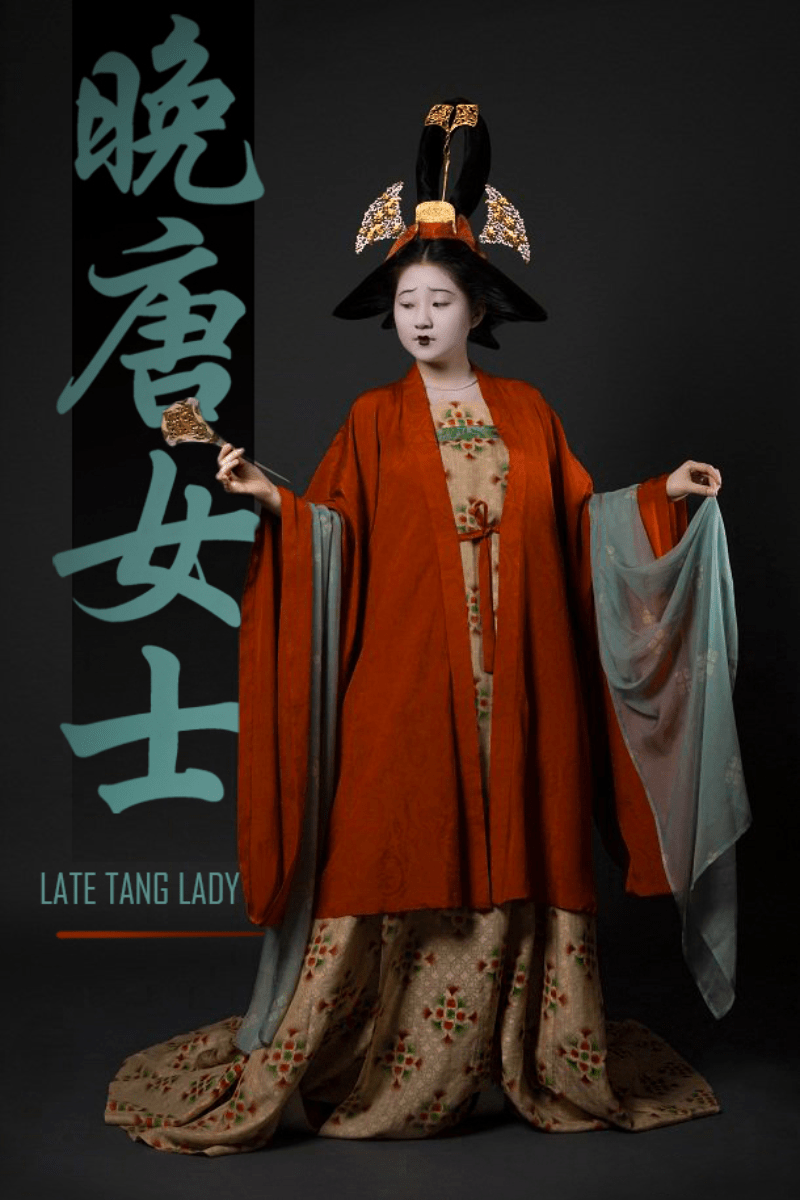Computational Couture: Algorithms in Ancient Proportions
The mathematical precision visible in Tang Dynasty construction reveals pattern-making principles that contemporary CAD systems struggle to replicate. The woman's red robe demonstrates proportional relationships between sleeve circumference, torso ease, and hem sweep that create visual harmony while accommodating extreme range of motion required for ceremonial bowing, tea service, and extended periods of formal positioning. These weren't arbitrary aesthetic choices—they represented solutions to complex engineering problems that modern garment construction approaches through trial-and-error methods rather than systematic mathematical frameworks.
Modern pattern drafting software attempts to digitize these proportional relationships but often misses the three-dimensional implications of Tang construction methods. The flowing sleeves that appear effortless actually require precise armscye calculations that distribute fabric weight evenly across the shoulder structure, preventing the drag that would restrict natural movement. Contemporary formal wear frequently fails at this fundamental challenge, creating garments that photograph beautifully but become physical constraints during actual wear.
The beige dress visible beneath the outer robe employs layering techniques that modern thermal wear has only recently begun to understand. Each layer serves specific functions: moisture wicking, structural support, decorative enhancement, while maintaining visual coherence across the complete ensemble. This systematic approach to multi-layer construction predates contemporary performance fabrics by millennia, yet achieves comparable functionality through pure engineering intelligence rather than material innovation.
Structural Intelligence: Ancient Engineering in Contemporary Applications
The princess seam construction principles evident in Tang formal wear translate directly to modern tailoring challenges that high-end menswear encounters when creating structured jackets for clients with athletic builds. The ancient Chinese approach to waist suppression achieves dramatic silhouette modification without creating the binding sensation that plagues contemporary formal wear. Their seaming techniques follow anatomical logic rather than arbitrary style requirements, creating garments that enhance natural body lines while providing structural support for extended wear periods.
Hand-canvassed construction methods used in superior bespoke work share fundamental DNA with Tang Dynasty internal structure systems. Both approaches prioritize flexibility within form, creating garments that maintain intended appearance while accommodating unpredictable movement demands. The floating chest piece technique that distinguishes quality tailoring from mass production operates on identical principles to the internal support systems visible in authentic Tang court dress, the kind of structural precision that separates bespoke craftsmanship from assembly-line production the way Pearl Jam separated grunge authenticity from hair metal's manufactured spectacle.
Modern fabric selection can learn from Tang approaches to natural fiber utilization that maximized performance characteristics available in eighth-century materials. Silk weights, weave structures, and finishing techniques developed during this period achieved durability and recovery properties that contemporary synthetic blends attempt to replicate through chemical treatments. The natural fibers favored in Tang construction possess inherent memory properties that allow garments to return to original form after stress, maintaining appearance integrity throughout extended ceremonial obligations.
Cultural Translation: Dynasty Aesthetics in Digital Age Construction
The visual impact of Tang Dynasty proportions, those dramatically flowing sleeves, the architectural precision of layered construction, the mathematical relationships between garment elements, can inform contemporary formal wear design without appropriating cultural elements inappropriately. The underlying engineering principles transcend cultural specificity, representing solutions to universal challenges that all advanced garment construction must address: weight distribution, thermal regulation, aesthetic proportion, and movement accommodation.
Contemporary formal wear construction often treats historical techniques as curiosities rather than advanced engineering solutions. Professional wardrobes evolved past the poorly constructed suits of the early 2000s, shouldn't modern pattern making evolve to incorporate the mathematical precision that Tang Dynasty artisans considered fundamental requirements? The sophisticated proportional systems developed during this period offer templates for solving contemporary fit challenges that standard grading methods cannot address effectively.
The white face makeup visible in traditional Tang presentations wasn't mere decoration, it represented sophisticated understanding of how color placement affects visual proportion assessment. Modern formal wear can apply similar principles through strategic fabric placement, seaming techniques, and detail positioning that enhance rather than distract from the wearer's natural features. These applications enhance contemporary garments while respecting the cultural contexts from which the principles originated.
The Reset Button: Revolutionizing Contemporary Construction Through Historical Wisdom
Traditional Western tailoring developed during periods when formal occasions required different physical demands than contemporary professional environments present. Tang Dynasty formal wear addressed challenges that modern networking events, extended presentations, and multi-climate professional travel create, garments that must transition seamlessly across diverse situations without requiring constant adjustment or creating physical restrictions that limit professional effectiveness.
The reset button mentality borrowed from Tang construction philosophy can inform contemporary formal wear durability and performance standards. Garments constructed using these principles maintain perfect appearance regardless of physical demands placed upon them during wear. Traditional contemporary formal wear construction is the sartorial equivalent of using dial-up internet in 2025, technically functional but fundamentally misaligned with current performance requirements and user expectations.
Modern construction techniques can incorporate Tang Dynasty innovations without cultural appropriation by focusing on the engineering principles rather than aesthetic elements. Strategic ease placement, proportional mathematics, and multi-layer functionality represent technical solutions that enhance contemporary garments regardless of cultural styling preferences. These applications improve garment performance while maintaining respect for the cultural contexts that developed these sophisticated approaches.
Advanced Construction Methodologies: Dynasty Techniques in Contemporary Practice
The translation from Tang Dynasty construction to high-end contemporary formal wear requires understanding how eighth-century solutions address twenty-first-century challenges. Palace court dress needed to maintain perfect appearance through ceremonies lasting entire days, in environments where temperature control was primitive and physical positioning requirements were extreme. These demands created innovation in construction techniques that benefit modern professionals navigating similarly challenging schedules and environmental conditions.
Floating lining systems employed in Tang construction allow outer fabrics to move independently while maintaining structural integrity and thermal regulation. This technique produces garments that breathe with the wearer while preserving intended silhouette and appearance standards throughout extended wear periods. Contemporary formal wear often features linings attached at multiple points, creating restriction and preventing the natural drape that Tang construction achieves through minimal attachment strategies.
Bias-cut panel integration, visible in Tang Dynasty construction, allows fabric to accommodate body movement without fighting against natural stretch and compression patterns. This construction method, when applied to contemporary jacket side panels and trouser inseams, eliminates the binding sensation that occurs when modern garments restrict natural movement. The result produces formal wear that adapts to the wearer rather than requiring physical accommodation from the person wearing the garment.
Technical Precision: Mathematical Relationships in Garment Architecture
The proportional systems governing Tang Dynasty construction operate on mathematical principles that contemporary pattern making has largely abandoned in favor of simplified industrial methods. The woman's costume demonstrates relationships between sleeve length, torso measurements, and hem circumference that create visual harmony while ensuring functional performance across the complete range of ceremonial requirements her role demanded.
Understanding these mathematical relationships enables contemporary tailors to create garments with similar architectural integrity. The sleeve-to-body ratios that create Tang Dynasty elegance translate to modern armscye calculations that eliminate shoulder restriction while maintaining clean presentation lines. The ease distribution methods that allow Tang robes to flow naturally inform contemporary jacket construction that achieves fitted appearance without creating binding sensations during normal movement.
Modern measuring techniques can incorporate Tang Dynasty approaches to three-dimensional fit assessment that consider dynamic requirements rather than static measurements alone. Traditional Tang construction calculated ease requirements for extreme positions, deep ceremonial bowing, extended arm positioning for tea service, prolonged sitting in formal positions, that created garments capable of accommodating full range of motion without appearance compromise.
Material Intelligence: Ancient Fiber Knowledge in Modern Applications
Tang Dynasty fabric selection demonstrates sophisticated understanding of natural fiber properties that contemporary material science validates through laboratory analysis. The silk weights and weave structures developed during this period maximized performance characteristics available in natural materials, achieving durability, recovery properties, and aesthetic qualities that modern synthetic attempts often fail to replicate successfully.
The layering systems visible in authentic Tang construction utilize different fabric weights strategically to achieve climate control, structural support, and aesthetic enhancement simultaneously. Each layer serves multiple functions while contributing to overall garment performance in ways that contemporary multi-layer systems attempt to achieve through specialized synthetic materials rather than pure engineering intelligence applied to natural fibers.
Recovery properties become crucial when garments must maintain appearance integrity throughout extended formal obligations. The natural fibers favored in Tang construction possess inherent resilience that allows them to return to original form after stress, maintaining visual perfection throughout day-long ceremonial requirements. Contemporary formal wear constructed with similar material consciousness performs reliably across diverse wearing conditions without requiring constant adjustment or maintenance interventions.
The Thick Skin Philosophy: Durability Through Systematic Design
The thick skin approach to garment construction, building resilience into fundamental structure rather than treating durability as afterthought consideration, appears throughout Tang Dynasty formal wear construction. These garments needed to withstand court ceremonies, seasonal climate variations, and storage periods between formal occasions while maintaining flawless appearance for close inspection by imperial observers who possessed sophisticated understanding of construction quality.
This philosophy translates directly to contemporary formal wear construction that anticipates and accommodates the stresses of modern professional life. Rather than creating delicate garments requiring careful handling, the thick skin approach produces formal wear that improves with use, developing character and patina that enhance rather than detract from overall appearance throughout the garment's service life.
Internal construction techniques borrowed from Tang Dynasty methods, strategic reinforcement placement, stress distribution systems, recovery-focused seaming, create contemporary formal wear capable of handling active professional and social schedules. The result produces clothing that supports rather than restricts authentic presence and natural movement, allowing wearers to focus on professional objectives rather than garment management concerns.
Contemporary Integration: Dynasty Wisdom in Modern Professional Context
Modern tailoring can incorporate Tang Dynasty construction principles without cultural appropriation by understanding underlying engineering rather than copying surface aesthetic elements. The structural intelligence that allows unrestricted movement while maintaining sophisticated visual impact represents technical knowledge that enhances contemporary formal wear regardless of cultural styling preferences applied to the finished garments.
Pattern drafting techniques that prioritize natural body movement create garments that feel custom-fitted rather than restrictive. Seam placement following anatomical logic rather than arbitrary style requirements allows full range of motion without compromising silhouette integrity. These approaches produce formal wear that enhances the wearer's natural presence rather than creating artificial constraints that telegraph discomfort or restriction during professional interactions.
The integration of performance-oriented construction with sophisticated styling creates formal wear that functions as impressively as it appears to observers. This represents evolution rather than revolution, taking proven elements of traditional tailoring craft and enhancing them with techniques proven effective under demanding historical conditions. The result supports authentic self-expression rather than requiring constant physical accommodation from the wearer.
Global Applications: Universal Principles in Cultural Context
The engineering principles underlying Tang Dynasty construction transcend cultural boundaries while maintaining respect for cultural origins. Weight distribution methods, proportional mathematics, and multi-functional layering represent technical solutions that apply to contemporary garment construction challenges regardless of aesthetic preferences or cultural styling choices applied to finished products.
Contemporary fashion education can integrate historical construction analysis into curricula that address advanced techniques alongside modern practices. Students gain appreciation for engineering development across cultures while learning applications that enhance their contemporary work. This integration creates more comprehensive technical education that acknowledges cultural foundations underlying modern garment construction without appropriating cultural elements inappropriately.
Professional development programs can incorporate historical technique analysis that informs contemporary problem-solving approaches. Understanding how Tang Dynasty construction solved complex engineering challenges provides frameworks for addressing similar problems in modern contexts. This historical perspective creates more sophisticated approaches to contemporary construction challenges while maintaining respect for cultural contexts that developed these advanced techniques.
Future Evolution: Historical Intelligence in Emerging Technologies
The intersection of Tang Dynasty construction principles and emerging manufacturing technologies suggests future developments that could transform contemporary formal wear production. Computer-aided design systems programmed with Tang proportional mathematics could create patterns that achieve historical elegance while accommodating modern production requirements and contemporary aesthetic preferences.
Advanced manufacturing techniques could replicate Tang Dynasty construction methods at production scales that make historically-informed construction accessible to broader markets. Automated systems programmed with Tang engineering principles could produce garments that achieve historical functionality while meeting contemporary production timelines and cost requirements.
The global networks developing around historical construction appreciation create opportunities for cultural exchange that benefits both traditional knowledge preservation and contemporary technical development. Practitioners can study Tang Dynasty techniques while contributing to evolution of these methods for contemporary applications, creating sustainable models for historical knowledge integration in modern contexts.
Contemporary formal wear informed by Tang Dynasty construction principles represents evolution that honors historical wisdom while addressing modern requirements. The woman standing in perfect stillness, her red robe flowing with mathematical precision over patterned layers, embodies centuries of accumulated engineering intelligence now applicable to contemporary professional wardrobes seeking authentic sophistication rather than superficial styling.
The architectural precision visible in her costume, proportional relationships, structural engineering, material utilization, can inform how modern tailoring approaches the challenge of creating formal wear that performs as beautifully as it appears. The flowing elegance that defined Tang Dynasty court dress demonstrates possibilities for contemporary formal wear that enhances human capability rather than restricting it, allowing wearers to navigate professional environments with grace, confidence, and unrestricted authenticity.




